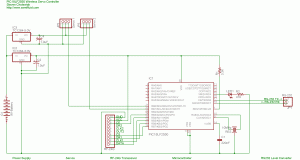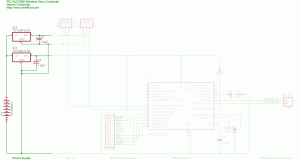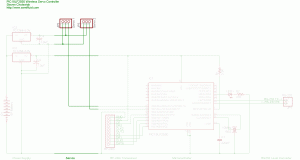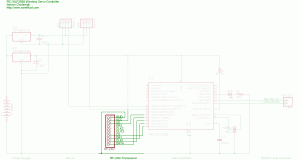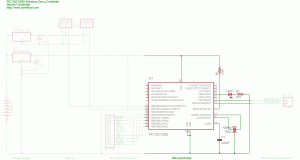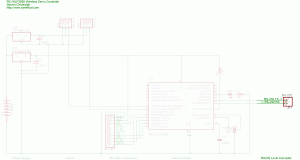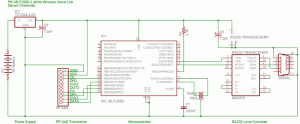 I’ve wanted to make a remote control pan–tilt controller for my wireless camera for some time now. It can be used for remote monitoring, as a webcam, or for color/object tracking. The basis for a pan-tilt configuration is the PIC18LF2550 Wireless Servo Controller, which allows me to control two servos remotely with very little latency (a majority of which is due to the slow response of the hobby servos being used).
I’ve wanted to make a remote control pan–tilt controller for my wireless camera for some time now. It can be used for remote monitoring, as a webcam, or for color/object tracking. The basis for a pan-tilt configuration is the PIC18LF2550 Wireless Servo Controller, which allows me to control two servos remotely with very little latency (a majority of which is due to the slow response of the hobby servos being used).
Receiver Circuit
The source and firmware for the receiver circuit can be found at the bottom of the page. Each section of the circuit is labeled in the schematic. All of the sections and their components are described and discussed below. The part numbers for the components are linked to websites for data and more information when available.
Receiver Power Supply
The power supply uses a 9 volt battery and a TC1264-3.0V high-accuracy low-dropout linear voltage regulator to provide a stable 3 volt supply for the microcontroller and the transceiver. An additional TC1262-5.0V high-accuracy low-dropout linear voltage regulator is used to provide a stable 5 volt supply for the servos. 1uF (microFarad) polarized decoupling capacitors are necessary on the outputs of the voltage regulators to prevent spikes or ripples. A wall wart power supply as low as 5.3V can be substituted for the 9 Volt battery.
Receiver Servos
I used two standard hobby servos that were bought on eBay. Any servos that conform to the standard RC servo control scheme can be used with this circuit.
Receiver RF-24G Transceiver
The Laipac TRW-24G 2.4GHz transceiver uses a Nordic Semiconductor nRF2401a transceiver chip and includes all of the necessary components. The TRW-24G (also called the RF-24G and TXRX24G) requires a 3 Volt power supply and 3 Volt logic, so running the transceiver at 5 volts is not a viable option. Information on the chip’s interface cam be found in the following data sheets:
– http://www.sparkfun.com/datasheets/RF/RF-24G_datasheet.pdf
– http://www.sparkfun.com/datasheets/RF/RF-24G.pdf
– http://www.sparkfun.com/datasheets/RF/nRF2401rev1_1.pdf
– https://www.sparkfun.com/datasheets/RF/RF-24G.pdf
Receiver Microcontroller
The microcontroller used was a Microchip PIC18LF2550. I modified the PIC18F2550 Tiny PIC Bootloader assembly file so I could use a 10MHz crystal/resonator at 57,600 baud (the modified bootloader can be found at the bottom of the page). The PIC18LF2550 runs at a maximum speed of 16MHz (4 MIPs) with a 3 Volt power supply; however, I had 10MHz and 20MHz ceramic resonators on-hand, so I ran at the fastest ‘safe’ speed possible (I could overclock the PIC by running it at 20MHz with a 3 volt supply, but it would be running out of spec. so it may not operate reliably). The firmware was written in C (using CCS PICC) and can be found at the bottom of the page, in addition to a generic RF-24G driver for Laipac TRW-24G 2.4GHz transceivers. R1 is a pull-up resistor necessary for operation. C1 is a stabilizing capacitor that is used for the onboard USB voltage regulator (which is not utilized in this project). The component marked ‘RES’ is a 10MHz resonator. The LED connected to pin C4 is used to indicate data reception and can be omitted if necessary (although it is helpful for debugging).
Receiver RS232 Level Converter
The microcontroller USART pins need to be connected to a RS-232 Level Converter to connect to a PC for firmware updates using the Tiny PIC Bootloader. Otherwise, after initial programming they can be left disconnected.
Transmitter Circuit
The circuit for the transmitter is exactly the same as the circuit for the 2.4GHz Serial Link; however, a custom firmware is used for the 2-byte payload of the RF-24G (1 byte for each servo). The firmware for the transmitter can be found below.
Source and Firmware
The PIC must initially programmed with the ‘SAC_tinybld18F2550_10MHz_57600’ hex file to program the bootloader on the PIC. Then, using Tiny PIC Bootloader, the hex files can be placed on the chips using the Tiny PIC Bootloader frontend with ’12h 34h 56h 78h 90h’ in the ‘List of codes to send first:’ in the ‘Options’ menu. Please feel free to contact me if you have any problems.
– SAC_tinybld18F2550_10MHz_57600.asm (hex)
– 18LF2550 RF-24G Serial Servo Transmitter.c (hex)
– 18LF2550 RF-24G Serial Servo Receiver.c (hex)
– RF-24G.c
Update – 02/28/2006
Here are two videos of my camera pan/tilt system under manual control: Manual Control. Here are two videos of my camera pan/tilt system under the control of a simple color tracking algorithm (which is configured to track the brightest red in the room): Color Tracking.
